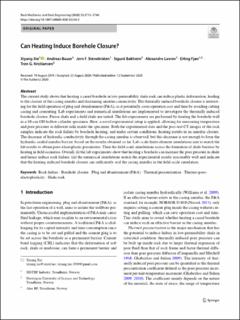| dc.contributor.author | Xie, Xiyang | |
| dc.contributor.author | Bauer, Andreas | |
| dc.contributor.author | Stenebråten, Jørn | |
| dc.contributor.author | Bakheim, Sigurd | |
| dc.contributor.author | Lavrov, Alexandre | |
| dc.contributor.author | Fjær, Erling | |
| dc.contributor.author | Kristiansen, Tron Golder | |
| dc.date.accessioned | 2021-02-26T12:03:42Z | |
| dc.date.available | 2021-02-26T12:03:42Z | |
| dc.date.created | 2020-11-12T11:24:34Z | |
| dc.date.issued | 2020 | |
| dc.identifier.issn | 0723-2632 | |
| dc.identifier.uri | https://hdl.handle.net/11250/2730655 | |
| dc.description.abstract | The current study shows that heating a cased borehole in low-permeability shale rock can induce plastic deformation, leading to the closure of the casing annulus and decreasing annulus connectivity. The thermally induced borehole closure is interesting for the field operation of plug and abandonment (P&A), as it potentially saves operation cost and time by avoiding cutting casing and cementing. Lab experiments and numerical simulations are implemented to investigate the thermally induced borehole closure. Pierre shale and a field shale are tested. The lab experiments are performed by heating the borehole wall in a 10-cm-OD hollow cylinder specimen. Here, a novel experimental setup is applied, allowing for measuring temperature and pore pressure at different radii inside the specimen. Both the experimental data and the post-test CT images of the rock samples indicate the rock failure by borehole heating, and under certain conditions, heating results in an annulus closure. The decrease of hydraulic conductivity through the casing annulus is observed, but this decrease is not enough to form the hydraulic-sealed annulus barrier, based on the results obtained so far. Lab-scale finite-element simulations aim to match the lab results to obtain poro-elastoplastic parameters. Then the field-scale simulations assess the formation of shale barriers by heating in field scenarios. Overall, (i) the lab experiments show that heating a borehole can increase the pore pressure in shale and hence induce rock failure; (ii) the numerical simulations match the experimental results reasonably well and indicate that the heating-induced borehole closure can sufficiently seal the casing annulus in the field-scale simulation. | en_US |
| dc.language.iso | eng | en_US |
| dc.publisher | Springer | en_US |
| dc.rights | Navngivelse 4.0 Internasjonal | * |
| dc.rights.uri | http://creativecommons.org/licenses/by/4.0/deed.no | * |
| dc.title | Can Heating Induce Borehole Closure? | en_US |
| dc.type | Peer reviewed | en_US |
| dc.type | Journal article | en_US |
| dc.description.version | publishedVersion | en_US |
| dc.source.journal | Rock Mechanics and Rock Engineering | en_US |
| dc.identifier.doi | 10.1007/s00603-020-02238-5 | |
| dc.identifier.cristin | 1847332 | |
| dc.relation.project | Norges forskningsråd: 244420 | en_US |
| dc.relation.project | SINTEF Petroleumsforskning AS: IK7021151 | en_US |
| dc.relation.project | Norges forskningsråd: 280650 | en_US |
| dc.description.localcode | This article is licensed under a Creative Commons Attribution 4.0 International License, which permits use, sharing, adaptation, distribution and reproduction in any medium or format, as long as you give appropriate credit to the original author(s) and the source, provide a link to the Creative Commons licence, and indicate if changes were made. The images or other third party material in this article are included in the article’s Creative Commons licence, unless indicated otherwise in a credit line to the material. If material is not included in the article’s Creative Commons licence and your intended use is not permitted by statutory regulation or exceeds the permitted use, you will need to obtain permission directly from the copyright holder. To view a copy of this licence, visit http://creativecommons.org/licenses/by/4.0/. | en_US |
| cristin.ispublished | true | |
| cristin.fulltext | original | |
| cristin.qualitycode | 2 | |

